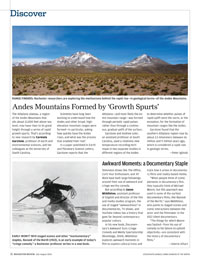Discover
 RANGE FINDERS: Rochester researchers are exploring the mechanisms behind the rapid rise—in geological terms—of the Andes Mountains. (Photo: iStockphoto)
RANGE FINDERS: Rochester researchers are exploring the mechanisms behind the rapid rise—in geological terms—of the Andes Mountains. (Photo: iStockphoto)The Atliplano plateau, a region of the Andes Mountains that sits about 12,000 feet above sea level, may have risen to its great height through a series of rapid growth spurts. That’s according to new research by Carmala Garzione, professor of earth and environmental sciences, and her colleagues at the University of South Carolina.
Scientists have long been working to understand how the Andes and other broad, high-elevation mountain ranges were formed—in particular, asking how quickly have the Andes risen, and what was the process that enabled their rise?
In a paper published in Earth and Planetary Science Letters, Garzione reports that the Altiplano—and most likely the entire mountain range—was formed through periodic rapid pulses rather than through a continuous, gradual uplift of the surface.
Garzione and Andrew Leier, an assistant professor at South Carolina, used a relatively new temperature-recording technique in two separate studies in different regions of the Andes to determine whether pulses of rapid uplift were the norm, or the exception, for the formation of mountain ranges like the Andes.
Garzione found that the southern Altiplano region rose by about 2.5 kilometers between 16 million and 9 million years ago, which is considered a rapid rate in geologic terms.
—Peter Iglinski
 VISUALIZE THIS: An interactive display wall will be the centerpiece of a new “data visualization lab” when the lab opens this fall in Carlson Library. Featuring a high-speed fiber-optic connection to the University Data Center, the facility is linked to an IBM Blue Gene/Q, one of the world’s most powerful supercomputers, and a new IBM “BlueHive 2” supercomputer cluster. Designed to create immersive visual experiences, the lab allows researchers to understand and manipulate large and complex sets of scientific information. (Photo: Adam Fenster)
VISUALIZE THIS: An interactive display wall will be the centerpiece of a new “data visualization lab” when the lab opens this fall in Carlson Library. Featuring a high-speed fiber-optic connection to the University Data Center, the facility is linked to an IBM Blue Gene/Q, one of the world’s most powerful supercomputers, and a new IBM “BlueHive 2” supercomputer cluster. Designed to create immersive visual experiences, the lab allows researchers to understand and manipulate large and complex sets of scientific information. (Photo: Adam Fenster)Awkward Moments: a Documentary Staple
Television shows like The Office, Curb Your Enthusiasm, and 30 Rock have built large followings around their use of awkward and cringe-worthy comedy.
But according to Jason Middleton, assistant professor of English and director of the film and media studies program, the use of staged “awkwardness” in documentaries, TV shows, and YouTube videos has a history that goes far beyond contemporary popular culture.
In his new book, Documen-tary’s Awkward Turn: Cringe Comedy and Media Spectatorship (Routledge, 2014), Middleton explores awkward moments in film to explore cultural irony and track how it arises in documentary films and reality-based media.
“When people think of comic elements in documentary film, they typically think of Michael Moore, but this approach was used in some of the earliest documentary films, like Nanook of the North,” says Middleton, who points to staged scenes and comic interactions between the actor and the filmmaker in the 1922 silent documentary. “The things for which Moore was faulted—from his use of comedy to his failure to uphold objectivity—are consistent with the history of documentary films.”
—Valerie Alhart
Do Hispanic Seniors Face Medicare Barriers?
Hispanic seniors are 35 percent less likely to have prescription drug coverage despite the existence of the Medicare Prescription Drug Plan—also known as Part D—and the availability of assistance to help pay insurance premiums.
The findings are part of a study published in the journal Health Affairs and coauthored by Robert Strawderman, chair of the Department of Biostatistics and Computational Biology, Yue Li, associate professor in the Department of Public Health Sciences, and Brian McGarry, a graduate student in the same department.
Medicare Part D was implemented in 2006 to help make prescription drugs, and premiums for prescription drug insurance plans, more affordable to seniors.
Using 2011 data from the National Health and Aging Trends Study, researchers found lower enrollment numbers for Hispanics despite the fact that an estimated 65 percent of Hispanics without coverage were eligible to receive premium support. The authors argue that addressing such disparities should be a public health priority.
—Mark Michaud
Study Finds Connection between Pollution and Autism
Medical Center research is providing new evidence that exposure to air pollution early in life may be harmful to brain development.
In a paper published in the journal Environmental Health Perspectives, Deborah Cory-Slechta, professor of environmental medicine, reported the results of three sets of experiments, in which her team exposed mice to levels of air pollution typically found in mid-sized U.S. cities during rush hour. The exposure was conducted during the first two weeks after birth, a critical time in the brain’s development.
The researchers found rampant inflammation throughout the brain, and the lateral ventricles—chambers on each side of the brain that contain cerebrospinal fluid—were enlarged two to three times their normal size.
Inflammation to that part of the brain is seen in humans who have autism and schizophrenia. The mice also performed poorly in tests of short-term memory, learning ability, and impulsivity.
The findings are consistent with several recent studies that have shown a link between air pollution and autism in children. Most notably, a 2013 study in JAMA Psychiatry reported that children who lived in areas with high levels of traffic-related air pollution during their first year of life were three times as likely to develop autism.
—Christopher DiFrancesco

